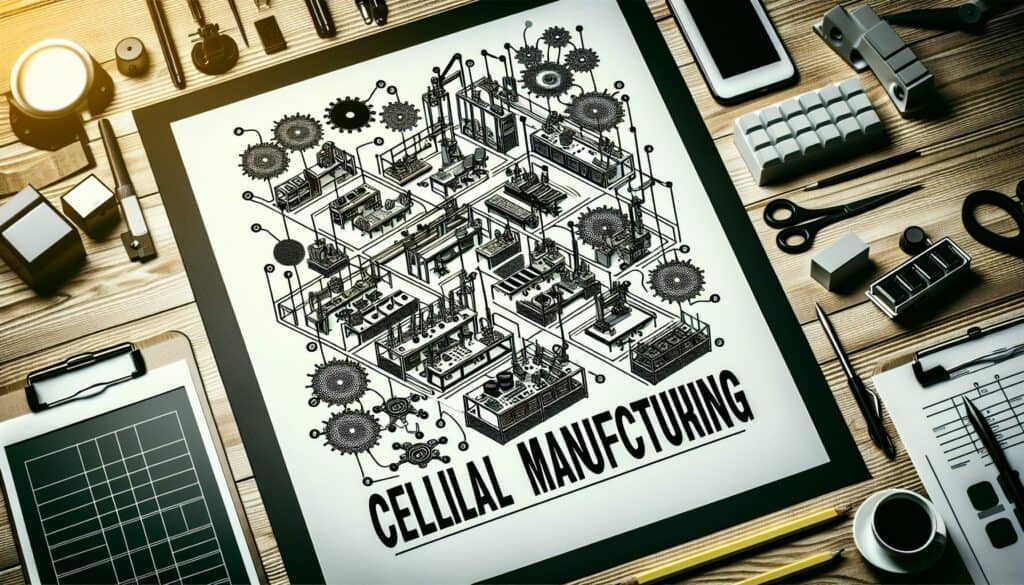Mejorar la eficacia de la producción agrupando máquinas distintas en células que trabajen con productos con requisitos de procesamiento similares (familias de piezas).
- Metodologías: Ingeniería, Calidad
Fabricación celular

Fabricación celular
- Mejora continua, Justo a tiempo (JIT), Manufactura esbelta, Mejora de procesos, Eficacia de la producción, Gestión de calidad, Mapeo del flujo de valor
Objetivo:
Cómo se utiliza:
- Los puestos de trabajo y los equipos están dispuestos en una secuencia que permite el flujo fluido de materiales y componentes a través del proceso de producción con un transporte y un retraso mínimos. Una célula se encarga de fabricar una familia de piezas similares.
Ventajas
- Reduce el inventario de trabajo en curso, los plazos de entrega y la manipulación de materiales; Mejora la flexibilidad, la moral de los trabajadores y la calidad; Ahorra espacio en la fábrica.
Contras
- Su implantación puede resultar costosa (reorganización del equipo, formación); requiere una planificación cuidadosa y la identificación de la familia de piezas; la utilización de la máquina dentro de una célula puede ser menor si no se equilibra adecuadamente; es vulnerable a las averías si falla una máquina de una célula.
Categorías:
- Lean Sigma, Fabricación, Diseño de producto
Ideal para:
- Mejora del flujo y la eficacia en la producción de alta variedad y volumen medio-bajo mediante la creación de unidades de producción específicas y centradas.
Cellular manufacturing is particularly effective in industries such as automotive, electronics, and appliance manufacturing, where product lines often consist of a variety of components requiring customized assembly processes. This methodology is most beneficial during the design and development phases of new products, where early collaboration among engineers, designers, and production teams can lead to more efficient workflows. The implementation of cellular manufacturing typically begins with a thorough analysis of the product family to identify similarities and group related components, which enables the design of cells that can efficiently deal with variations in production. Participants including production supervisors, quality assurance personnel, and manufacturing engineers are crucial in defining the specific tasks and responsibilities within each cell. This collaborative approach not only enhances communication among team members but also fosters a sense of ownership and accountability, leading to improved worker morale. Furthermore, the layout of the production area can facilitate better ergonomic practices and minimize operator fatigue, which in turn translates to higher quality outputs and lower defect rates. Companies that incorporate cellular manufacturing may use techniques such as just-in-time inventory and principios lean to further enhance productivity, thereby reducing costs associated with excess inventory and prolonging lead times. Continuous improvement initiatives, like Kaizen, are often applied alongside cellular manufacturing, allowing teams to regularly assess and refine their processes to stay competitive in fast-paced markets.
Pasos clave de esta metodología
- Identify the family of similar parts to be produced.
- Design the cellular layout considering the workflow and space efficiency.
- Group equipment and workstations based on the sequence of operations needed.
- Assign team members to specific roles within the cell based on skill sets.
- Implement standardized work procedures for each operation within the cell.
- Establish visual controls and tools to monitor workflow and quality.
- Conduct regular reviews and adjustments based on performance and feedback.
- Train staff on cell operation and encourage cross-training for flexibility.
- Iterate designs and processes based on efficiency metrics and product quality.
Consejos profesionales
- Analyze process flow regularly to identify bottlenecks and balance workloads across workstations for optimal efficiency.
- Implement cross-training for workers to enhance flexibility, allowing easy movement between tasks and cells as demand fluctuates.
- Utilize performance metrics to assess cell effectiveness continuously, adjusting layout and resources based on real-time production data.
Leer y comparar varias metodologías, recomendamos el
> Amplio repositorio de metodologías <
junto con otras más de 400 metodologías.
Sus comentarios sobre esta metodología o información adicional son bienvenidos en la dirección sección de comentarios ↓ , así como cualquier idea o enlace relacionado con la ingeniería.
Contexto histórico
1949
1950
1950
1960
1960
1960
1960
1940
1950
1950
1958
1960
1960
1960
1960
(si se desconoce la fecha o no es relevante, por ejemplo "mecánica de fluidos", se ofrece una estimación redondeada de su notable aparición)















Publicaciones relacionadas
Calculadora de METS a calorías
Metaanálisis
Asignación de mensajes
Diagramas de modelos mentales
Fuerzas de empuje y tracción máximas admisibles
Planificación de necesidades de material (MRP)